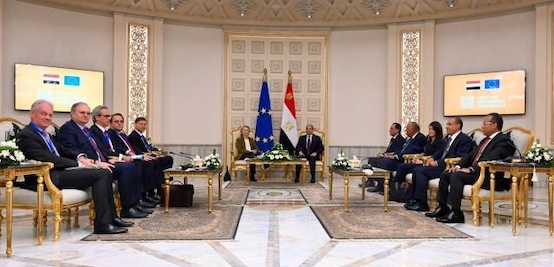#Europe
Building an economic governance framework fit for the challenges ahead
The orientations seek to ensure that the framework is simpler, more transparent and effective, with greater national ownership and better enforcement, while allowing for reform and investment and reducing high public debt ratios in a realistic, gradual and sustained manner. In this way, the reformed framework should help build the green, digital and resilient economy of the future, while ensuring the sustainability of public finances in all Member States, in line with President von der Leyen's 2022 State of the Union address. Today's Communication follows extensive outreach to stakeholders and Member States.
National plans to ensure debt sustainability and enhance sustainable growth, anchored in a common EU framework
It is proposed to move to a transparent risk-based EU surveillance framework that differentiates between countries by taking into account their public debt challenges. National medium-term fiscal-structural plans are the cornerstone of the Commission's proposed framework. They would integrate fiscal, reform and investment objectives, including those to address macroeconomic imbalances where necessary, into a single holistic medium-term plan, thus creating a coherent and streamlined process. Member States would have greater leeway in setting their fiscal adjustment path, strengthening the national ownership of their fiscal trajectories.
A single operational indicator – net primary expenditure, i.e. the expenditure which is in a government's control – would serve as a basis for setting the fiscal adjustment path and carrying out annual fiscal surveillance, thereby significantly simplifying the framework.
How it would work:
- As part of the common EU framework, the Commission would present a reference fiscal adjustment path, covering a period of four years, based on its debt sustainability analysis methodology. This reference adjustment path should ensure that debt of Member States with substantial or medium debt challenges would be put on a plausible downward path, and that the deficit would remain credibly below the 3% of GDP reference value set out in the Treaty.
- Member States would then submit plans setting out their medium-term fiscal path, and priority reform and public investment commitments. Member States could propose a longer adjustment period, extending the fiscal adjustment path by up to three years when the path is underpinned by a set of reform and investment commitments that support debt sustainability and respond to common EU priorities and targets.
- As a third step, the Commission would assess the plans, providing a positive assessment if debt is placed on a downward path or stays at prudent levels, and the budget deficit remains credibly below the 3% of GDP reference value over the medium term. The Council would endorse the plans following a positive assessment from the Commission.
- Finally, the Commission would continuously monitor the implementation of the plans. Member States would submit annual progress reports on the implementation of the plans to facilitate effective monitoring and ensure transparency.
More scope would be given to Member States for the design of their fiscal trajectories. At the same time, we are also putting in place more stringent EU enforcement tools to ensure delivery. The deficit-based excessive deficit procedure (EDP) would be maintained, while the debt-based EDP would be reinforced. It would be activated when a Member State with debt above 60% of GDP deviates from the agreed expenditure path.
Enforcement mechanisms would be reinforced: the use of financial sanctions would be made more effective by lowering their amounts. There would also be stronger reputational sanctions. The macroeconomic conditionality for structural funds and for the Recovery and Resilience Facility would be applied in a similar spirit, i.e. EU financing could also be suspended when Member States have not taken effective action to correct their excessive deficit.
In addition, a new tool would ensure the implementation of reform and investment commitments underpinning a longer adjustment path. A failure to implement reform and investment commitments could result in a more restrictive adjustment path and, for euro area Member States, the imposition of financial sanctions.
More effectively preventing and correcting harmful imbalances
The Macroeconomic Imbalance Procedure (MIP) aims to identify potential macroeconomic risks early on, prevent the emergence of harmful macroeconomic imbalances and correct the imbalances that already exist. The reform proposals for the MIP centre on an enhanced dialogue between the Commission and Member States to create a better common understanding of the challenges identified under the MIP and the policies needed to address them. This would, in turn, lead to a commitment from Member States to include the reforms and investments needed to prevent or correct imbalances in their national medium-term fiscal-structural plan.
The preventive role of the MIP would be strengthened in a macroeconomic environment characterised by new and evolving risks. The assessment of whether imbalances exist would be made more forward-looking with a view to detecting and addressing emerging imbalances early on. More weight would be placed on trend developments and on whether policies have been implemented to address imbalances, when assessing whether imbalances have been corrected.
A more focused and streamlined post-programme surveillance framework
Post-programme surveillance assesses the repayment capacity of Member States that have benefited from financial assistance programmes. As part of the new framework, and while keeping the legislative text unchanged, the Commission proposes to apply it differently by setting clearer objectives, with the intensity of the framework linked to these objectives. In particular, post-programme surveillance would focus on assessing repayment capacity, monitoring the implementation of unfinished reforms, and assessing whether corrective measures are needed in the context of concerns for repayment capacity or continued market access.
The intensity of post-programme surveillance would evolve over time, along with the evolving risk assessment.
Next steps
Swift agreement on revising the EU fiscal rules and other elements of the economic governance framework is a pressing priority at the current critical juncture for the EU economy. Member States and the Commission should reach a consensus on the reform of the economic governance framework ahead of Member States' budgetary processes for 2024.
The Commission will consider tabling legislative proposals on the basis of today's Communication and the ensuing discussions. It will again provide guidance for fiscal policy for the period ahead in the first quarter of 2023. This guidance will facilitate the coordination of fiscal policies and the preparation of Member States' stability and convergence programmes for 2024 and beyond.
Background
Since the Treaty of Maastricht of 1992, the EU's economic governance framework has helped to create conditions for economic stability, sustainable economic growth and higher employment. This framework consists of the EU fiscal policy framework (the Stability and Growth Pact, the European Semester, and requirements for national fiscal frameworks), the Macroeconomic Imbalances Procedure, and the framework for macroeconomic financial assistance programmes.
However, while the framework has evolved over time to address certain weaknesses, it has also grown increasingly complex and not all instruments and procedures have stood the test of time.
The reform proposals set out in the Communication follow a review of the effectiveness of the economic surveillance framework first launched in February 2020 (and relaunched in October 2021). The review was carried out in line with the so-called six-pack and two-pack legislative reforms, which require the Commission to review and report on the application of the legislation every five years. Today's orientations take into account the extensive public debate and consultation process where a wide range of stakeholders expressed their views on the key objectives of the framework, its functioning, and new challenges to be addressed.
The lessons learned from the policy responses to recent economic shocks, including the interaction between reforms and investment under the Recovery and Resilience Facility, have informed the Commission's proposal for a reformed framework. The reform proposals are also shaped by the higher and more diverse public deb














